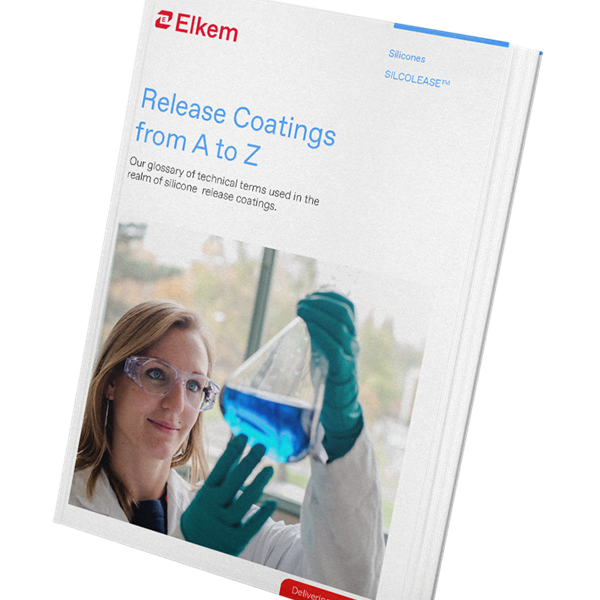- Elkem
- Products
- Silicones
- Silicone for paper and film coatings
- What are UV cure silicones?
What are UV cure silicones?
UV cure silicones: The essentials
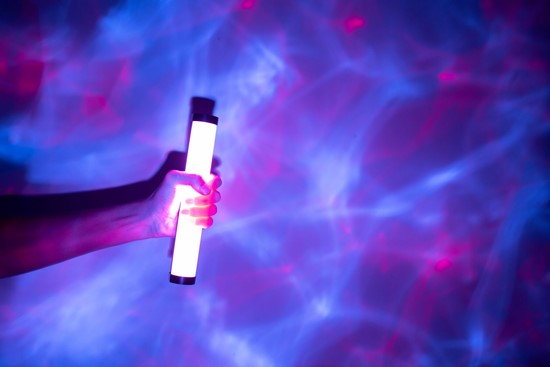
Silicones are widely used as release coatings on liners for tapes and labels, because their low surface energy makes the liner easy to remove. These silicones are typically applied to the substrate in liquid form (with solventless and emulsion-based technologies having overtaken the formerly widespread solvent-based products), and then crosslinked (cured) to form a solid layer.
There are various chemistries for polymer crosslinking in general, but the commonest one used with silicones involves an initiator as part of the formulation. Upon irradiation with ultraviolet (UV) light, this initiator releases radical species that form links between the long silicone chains, turning the liquid formulation (known as a UV-cure silicone) into a thin layer of solid.
The curing of silicones by heat is another commonly used option, but there are drawbacks, in the form of the restricted substrates that can be used, the energy-intensiveness of the process, and the need for multiple additives within the formulation.
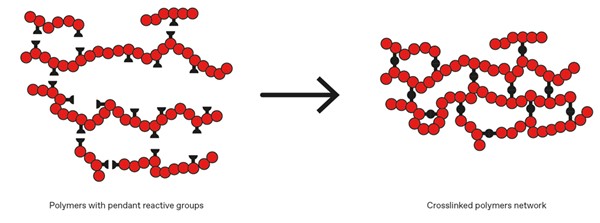
Illustration of polymer chemistry transforming formulations into post-polymer crosslinking solids
|
Comparison of mercury vapor lamps and UV LEDs for curing
Ever since UV cure silicones were introduced, irradiation has typically used mercury vapor lamps. Although these work well, mercury is toxic and under increasingly tight regulation. As a result, manufacturers are looking to replace them with safer and more sustainable alternatives.
Light-emitting diodes (LEDs) that emit in the UV range were invented in the early 2000s, and since then they have undergone considerable improvements in the range of wavelengths offered, power, energy-efficiency and affordability. As a result, they have been in use for some years for curing of printing inks and varnishes, and have now reached the point where they present an appealing alternative to mercury vapor lamps for curing of silicone coatings.
The key advantages of UV LED curable silicones are their better safety profile and lower energy requirements. A full comparison is provided in the table below.
| Mercury vapor lamps | UV LED lamps | |
|---|---|---|
| Contain hazardous mercury | Environmentally benign | |
| High energy usage (and associated running costs and carbon emissions) | 50% lower energy usage (and associated running costs and carbon emissions) | |
| Emit a broad range of UV wavelengths (UVA, UVB, UVC) | Emit UVA only | |
| Release ozone (as a result of UVC interaction with atmospheric oxygen) | Do not release ozone | |
| Bulky and fragile | Compact and robust | |
| Operational life ~2000 hours | Operational life 20,000–50,000 hours | |
| Take time to warm up | Are ready instantly | |
| Emit infra-red, and so require cooling | Do not emit infra-red, and so do not require cooling | |
| High irradiance at all UV wavelengths | High irradiance only from 380–390 nm | |
| Output up to 240 W/cm (across all wavelengths) | Output up to 80 W/cm (single wavelength) | |
| Multi-directional; reflector required | Uni-directional; no reflector required | |
| Work with a range of radical initiators | Work only with specified radical initiators |

SILCOLEASE™ silicone release coatings
This guide will give you more information about silicones used for release coatings, and advice on substrate choice.
Tailored silicone formulations
Despite the advantages of UV LED lamps for curing of silicones, until now there has been a barrier to implementing this technology for UV-cure silicone release liners – namely, their wavelength range.
Whereas mercury vapor lamps generate wavelengths across the full UV spectrum (100–400 nm), UV LED lamps produce a single much narrower band at a defined wavelength (e.g. 375–395 nm). This means that the initiator needs to be precisely tailored to the UV wavelength in order for the silicone formulation to cure efficiently.
However, this barrier to adoption of UV LED technology has now been removed with the development by Elkem of a curing system for silicones that reliably and efficiently works with 385 nm UV light from an LED.
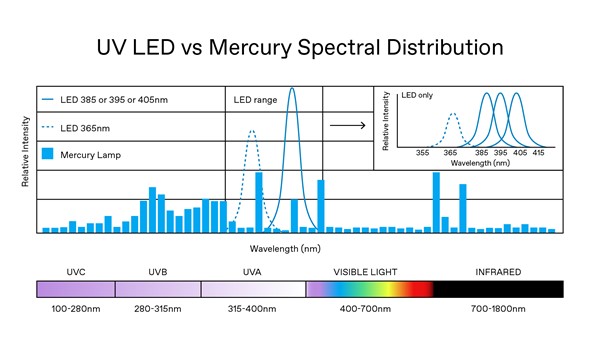
Graphic comparing the UV LED vs Mercury Spectral Distribution
|
UV LED curable silicones from Elkem
The new curing system for silicones is implemented in Elkem’s growing range of UV LED curable silicones for use as release liners on labels, papers and films:
- SILCOLEASE™ UV POLY 125: Suitable for a variety of pressure-sensitive label applications
- SILCOLEASE™ UV POLY 126: Optimized for release coating of linerless (self-wound) thermal labels.
- SILCOLEASE™ UV POLY 127: Suitable for general-purpose label release.
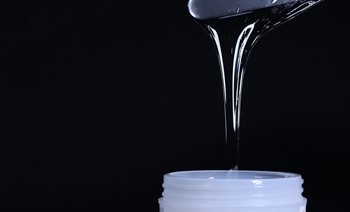
These silicone formulations are optimized to work with both mercury vapor lamps and defined-wavelength UV LED lamps, giving equally good surface properties with both – enabling manufacturers to transition to the new curing technology over a period of time.
Another benefit is that our SILCOLEASE™ UV products are provided ‘ready to use’, meaning that they only need to be homogenized before application.
Related Applications
Contact us
Take your business to the next level by partnering with a world-leading material manufacturer.
